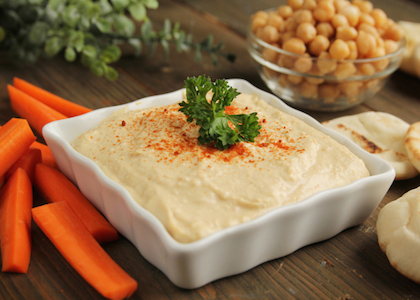
Hummus: Your Healthy Holiday Survival Snack (+16 Ways to Eat It!)
By Kristen DeAngelis
Hummus is a tasty and healthy option to serve at your next holiday party, or to have any day of the week as a nutritious snack, spread, or dressing for a side dish. Get maximum nutrition with this middle-eastern favorite for only 50 calories per serving (2 Tbsp.), 1.5 g protein, 1-2 g fiber, 1 g of healthy fats and a good source of important vitamins and minerals! Test out personalized homemade versions and be on your way to a new favorite healthy holiday snack that doesn’t involve heavy cream or sugar!
Health benefits of hummus:
- Rich in Healthy Fats: High in mono and polyunsaturated fats, hummus helps to lower blood cholesterol and provides protective cell, brain, and heart health functions.
- High in Fiber: Fiber helps you feel full, aids in digestion, and can help regulate blood sugars allowing hummus to be beneficial for weight loss and serve as a diabetic-friendly snack: 1/3 cup provides 4 g fiber, helping you meet your 25 g per day recommendation.
- Good source of Folate, Iron, Manganese and Zinc: Important for cell growth, development and oxygen transport.
- Powerful Protein Source: One serving has 1.5 g protein from the chickpeas, with additional amino acids from the tahini paste to help reach your daily protein needs.
- Low in Sodium and Calories: 1 serving has 73 mg. sodium, and roughly 50 calories.
How to eat more hummus:
- Homemade: Make your own (original recipe provided below but get creative with additional spices and vegetables: roasted red peppers, jalapenos, spinach, kale, artichoke, roasted tomatoes, cumin, cayenne, or paprika) or try these hummus recipes:
Rainbow Hummus
Pumpkin Hummus - Commercially prepared: If choosing at the grocery store, review the label and choose options low in sodium, fat, and calories, which can vary between brands.
- Think ‘Practical’: Scoop homemade hummus into small pre-portioned containers to take for on– the–go snacks. Some commercial brands have even begun selling small packaged portions to make hummus a portable snack.
- Portion Size: Standard servings are usually 2 Tbsp./30 mg. but it can be easy to over indulge. Measure out servings to help to stay in moderation.
What to do with your hummus:
- Snack Attack:
– Spread on apple or pear slices, or juicy tomatoes with basil to garnish
– Dip with raw vegetables like carrots, broccoli, and celery sticks
- Appetizer/Side Dish:
– Party Dip: Serve in a small dish centered around various raw cut vegetables or whole grain pita crisps
– Finger Bites: Place 1 Tbsp. on pre-cut cucumber rounds topped with a sliced olive, tomato, or roasted red pepper
- Sandwich Spread:
Swap out mayo or creamy dressings for hummus paired for your next grilled Panini or whole-grain sandwich/wrap:
– Classic Mediterranean: Hummus, tabbouleh, lettuce, tomato, onion
– Grilled Vegetarian: Hummus, roasted red peppers, eggplant, zucchini/squash
- Pasta Sauce:
– Toss ¼ cup/60 mg. hummus into a sauce with vegetable broth, and 2 Tbsp./30 ml. red wine vinegar, 2 Tbsp./30 ml. low-sodium soy sauce, 1 Tbsp./15 ml. sesame oil for an Asian flair over your choice of whole grain noodles or spaghetti squash.
- Hummus Flatbread Pizza:
– Swap the sodium loaded red sauce and frozen pizza dinners by brushing whole grain warmed pitas with hummus, chopped cucumber, tomato, kalamata olives, diced red onion, and baby arugula.
- Hummus Rotini Pasta Salad:
– Mix hummus with olive oil, rice wine vinegar, toasted almonds, parsley, salt and pepper. Toss over whole grain noodles or mixed vegetables (shredded cabbage, carrots, and broccoli slaw).
Ingredients
- 1 15-ounce can (425 grams) chickpeas, also called garbanzo beans, rinsed and drained
- 1/4 cup (60 ml) fresh lemon juice, about 1 large lemon
- 1/4 cup (60 g) tahini
- Large garlic clove, minced
- 2 tbsp (30 ml) olive oil, plus more for serving
- Dash of sea salt, to taste
- Dash of ground cumin (about 1/2 teaspoon/3.5 g)
- 2 – 3 tbsp (30 ml) water
- Dash of ground paprika, for serving
Directions
- In your food processor or blender, blend tahini and lemon juice for 1 minute.
- Add olive oil, minced garlic, cumin and salt and blend for another minute.
- Add canned/soaked chickpeas and process until thick and smooth. (You may have to add additional 2-3 Tbsp. water until desired consistency
- Serve with carrots, cucumber or whole grain pita.
Servings: 8
Calories: 120
Fat: 8g
Trans Fat: 1g
Cholesterol: 0mg
Sodium: 120mg
Carbohydrates: 9g
Fiber: 2g
Sugars: 1g
Protein: 3g